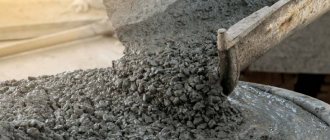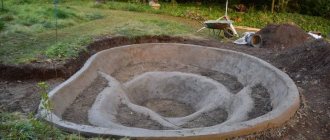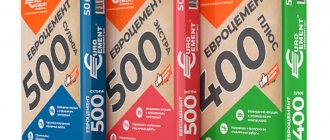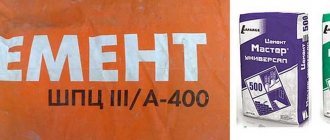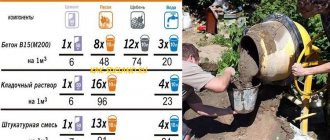Cement grade M400 (according to the new classification - CEM 32.5) is one of the most popular building materials that have found application in individual, public and industrial construction. It is a dry powder, which, in interaction with water, is transformed into a plastic solution, which turns into a solid state when solidified and does not lose its strength properties for decades. A positive property of M400 cement is its almost identical ability to harden in air and water environments, which significantly expands the scope of its use in capital construction and repair work.
Scope of application
M400 grade cement is suitable for general construction and finishing works:
- Arrangement of all types of foundations (strip, pile, slab);
- Construction of walls and columns;
- Preparation of plaster and repair mortars;
- Mixing concrete for laying paths.
From cement m 400, concrete M100...M450 is obtained. Moreover, the lower the grade of concrete, the lower the consumption of binder compared to the total volume of components. The mixing proportions are shown in the table:
| Expected grade of concrete | Proportions by weight (kg) C:P:SH* | Proportions by volume per 10 l PC (l) P:SH | Concrete yield from 10 liters of PC (l) |
| M450 | 1 : 1,1 : 2,5 | 10 : 22 | 29 |
| M400 | 1 : 1,2 2,7 | 11 : 24 | 31 |
| M300 | 1 : 1,9 : 3,7 | 17 : 32 | 41 |
| M250 | 1 : 2,1 : 3,9 | 19 : 34 | 43 |
| M200 | 1 : 2,8 : 4,8 | 25 : 42 | 54 |
| M150 | 1 : 3,5 : 5,7 | 32 : 50 | 64 |
| M100 | 1 : 4,6 : 7,0 | 41 : 61 | 78 |
*C – cement, P – sand, Shch – crushed stone.
Calculation of density value
If you urgently need cement density of 500 at a construction site, you can solve the problem by using the Le Chatelier device (combining a funnel and a vessel such as a measuring cylinder), or using homemade methods using improvised devices. In fact, special technology can be replaced by using a liter container and scales.
- Find out the weight of a 1 liter vessel (M1; V).
- Fill the selected container with bulk substance (without tamping or shaking).
- Weigh the vessel that is filled with the dry component mass (M2).
- Calculate the density of 500th cement (specific) using the formula: (M2-M1)/V.
A worker who has an accurate result can also calculate the specific gravity indicator, and then determine the required amount of powder so that during special work it will be possible to produce concrete with a particular strength.
Production
Cement binder is a product of clinker grinding with a standardized composition. The characteristics of raw materials are determined by GOST 10178-85. According to the document, the content of magnesium oxide should not exceed 5% (in some cases - 6%), and the amount of other components is determined by the type of binder and its purpose.
The raw materials for production are natural minerals (alite, alumina, magnesite, gypsum); each has its own compliance regulations. Clinker is produced from raw materials by firing.
The main component can be combined with mineral additives that affect the individual properties of the working solution and the finished stone. The number of the latter also determines the standard (Table 1):
Various additives can be added to the composition of M400 cement to improve the plasticity of the solution, the frost resistance of concrete, and the resistance of the structure to aggressive influences. Their total amount should not exceed 5% by weight of the binder component.
Clinker with the calculated amount of additives is crushed in drums up to 92%.
Areas of use of Portland cement M400
The material is recommended for use in the formation of monolithic foundations and reinforced concrete slabs, high-rise concrete structures, underground facilities and residential buildings. Products made on the basis of M400 cement are resistant to constant exposure to moisture and frequent temperature changes, have stable geometric parameters and adequate strength. Portland cement of the described brand is suitable for mixing sand-cement plaster mortars, preparing standard masonry mixtures and concreting loaded building structures. It is also used for:
- production of finishing and building materials such as expanded clay concrete blocks or paving slabs;
- production of load-bearing structural elements, including floor slabs;
- construction of bridges, overpasses and other loaded structures;
- arrangement of pile foundations of capital buildings;
- molding all kinds of reinforced concrete products for general use - trays, boxes, prefabricated blocks, curb parts, etc.
Types of cement grade 400
Binder with strength grade M400 can be produced on the basis of different components; depending on this, the material is divided into several main groups:
- Portland cement (PC) is the most common type, produced on the basis of calcium silicates (alite). These are metamorphic rocks. It is characterized by medium-term hardening and high technical characteristics.
- Aluminous cement (GC or VGC) is produced on the basis of aluminum, calcium, iron and silicon oxides in accordance with GOST 969-91. The material is characterized by accelerated setting and hardening. Suitable for urgent construction, including in winter.
- Magnesia cement (MGC) is a product of grinding clinker with a high magnesium content. The hardened stone is characterized by high wear resistance and density.
- Pozzolanic cements (PPCs) are made from volcanic rocks that are carefully crushed to a powdery state. Suitable for production are siliceous and aluminous mineral substances, some types of slag and fly ash, which have significant viscosity.
- Slag Portland cement (SPC) is a binder made from clinker and blast furnace or electrothermophosphorus slag with the amount of the latter not exceeding 20%. This binder is cheaper than the classic one; it is used when it is necessary to equip structures in aggressive environments and mineralized waters.
New marking of cement mixtures M400
As a rule, most Russian companies producing Portland cement use the above-mentioned labeling option. However, it is already slightly outdated, therefore, based on GOST 31108-2003, a new, additional marking method was developed, adopted in the European Union, which is becoming more common.
- CEM. This marking indicates that this is pure Portland cement without any additional ingredients.
- CEMII - indicates the presence of slag in the composition of Portland cement. Depending on the level of content of this component, the compositions are divided into two subtypes: the first, marked “A”, contains 6-20% slag, and the second, “B”, contains 20-35% of this substance.
According to GOST 31108-2003, the grade of Portland cement has ceased to be the main indicator; now it has become the level of strength. Thus, the composition M400 began to be designated B30. The letter “B” is added to the marking of quick-hardening cement D20.
By watching the following video, you can learn how to choose the right cement for mortar.
This is interesting: Cement m500 - technical characteristics
Marking
Cement M400 is a general designation for a binder; the full marking contains complete information about the material in accordance with GOST 10178-85. Using the example of PC 400-D20-B-PL GOST 10178-85:
- PC – Portland cement on alite clinker;
- 400 – grade of binder when tested in compression;
- D20 – designation of the amount of mineral additives as a percentage, that is, in this case, impurities 20%;
- B – fast-hardening, maybe “N” – normally hardening;
- PL – plasticized, maybe “GF” – hydrophobized. This paragraph reveals the function of additional additives;
- GOST 10178-85 is a regulatory document on the basis of which the material is manufactured and tested.
According to GOST 31108-2003, the designation of the same cement is different: TsEM I 32.5B GOST 31108-2003. This standard summarizes groups of cements of different strengths within a certain framework, reflected in the table:
| Cement strength class | Compressive strength, MPa, aged | |||
| 2 days, no less | 7 days, no less | 28 days | ||
| no less | no more | |||
| 22.5N | — | 11 | 22,5 | 42,5 |
| 32.5N | — | 16 | 32,5 | 52,5 |
| 32.5B | 10 | — | ||
| 42.5N | 10 | — | 42,5 | 62,5 |
| 42.5B | 20 | — | ||
| 52.5N | 20 | — | 52,5 | — |
| 52.5B | 30 | — | ||
The compressive strength of cement PC 400 at the age of 28 days according to GOST 10178-85 is 39.2 MPa, which is within the range of values for class 32.5 N/B.
Cement type designations according to GOST 31108-2003:
- CEM I – PC;
- CEM II – PC with mineral components;
- CEM III – ShPTs;
- CEM IV – PPC;
- CEM V is a composite binder made from several fundamental components.
Composition and general purpose
The presented type of cement is in great demand today in the field of construction. The reason for this popularity is related to the technical characteristics that this product boasts. Even by external signs, M400 cement is very easy to distinguish from ordinary material.
Classic Portland cement refers to a material that contains a binder obtained from clinker with gypsum and special additives. Clinker is the result of burning limestone and clay with the addition of other components. As for gypsum, this ingredient is necessary so that the adhesion time can be adjusted.
Portland cement
Portland cement M400 GOST 31108 2003 is a very common building material. To obtain this brand of cement, gypsum and clinker are also used, but active mineral components are used as additives. This product is characterized by high resistance to the influence of sulfate-containing waters. When using M400, a very strong adhesion of the solution to the material is achieved. The cement clinker required for the production of M400 is obtained by firing.
How to use cement grade 400 can be found in this article.
Additive-free brands
Today, additive-free cement comes in three types:
- M400 D0,
- M400 D20B
- M400 D20.
Each of them has its own properties, composition, as well as scope of use and general construction purpose. If you need the solution to harden faster, then you should use M400 D0. This product is characterized by high water resistance, which allows it to be used in the construction of underwater and underground structures. This brand of cement has also proven itself well in the production of prefabricated concrete and reinforced concrete structures.
What are the proportions of cement and sand for floor screed can be found in the article.
The material M400 D20 contains active mineral additives in its composition, which allowed it to be used in the construction of residential buildings, industrial and agricultural buildings. This cement is actively used in Russia and Europe. It can be used in the manufacture of construction solutions. Hardening time is 10-12 hours. The main advantages of M400 D20 remain high water resistance and excellent frost resistance.
How to correctly apply ready-made masonry cement mortar 100 GOST grade can be found in this article.
The next grade of cement is M400 D20B. The material belongs to a quick-hardening mixture. It is actively used in the construction of industrial buildings. The main feature of this brand remains its great strength, which is noticeable after just a few minutes of hardening.
What cement consists of can be found in this article.
Specifications
General characteristics for all types of M400 cements:
- Compressive strength at the age of 28 days for cement 400 spts, pc and others - 39.2 MPa, which corresponds to grade 400;
- The bulk density of dry cement m400 depends on the clinker grinding fraction and the presence of impurities, on average it is 1000...1200 kg/m3. Compacted cement weighs up to 1700 kg/m3, and moistened cement weighs like concrete - up to 3000 tons per cubic meter. For calculations, the specific gravity of cement m400 is taken at an average value of 1100 kg/m3;
- Hardening speed: start of setting no later than 2 hours, strength gain up to 98% - after 28 days;
- PC has insufficient resistance to aggressive environments, including sulfates. To increase stability, use cement m400 d20 with special additives (slag, additives);
- Frost resistance not less than F100;
- Operating operating temperature range -60…+300°С;
- The water resistance of mature stone is high; to achieve absolute impermeability, structure sealants are introduced into the composition and additionally waterproofed.
The volumetric weight of M400 cement varies due to storage conditions, transportation and production details. Various additives affect the density of the mixture. However, knowing this indicator will help you avoid purchasing a poorly-made, outdated or moistened binder!
The average weight of 1 m3 of m400 cement should be 1100-1200 kg/m3. Exceeding the value may indicate long-term storage of the material, which is why compaction has occurred. The reason for the increase in weight may be depressurization of the packaging and moistening of the binder.
The shelf life of cement m400 in paper bags is 6 months; for polyethylene containers and packaging, GOST specifies 12 months. However, it is possible to obtain concrete or cement mortar of the expected grade only using PC within 2 months from the date of shipment. Over time, the design strength of dry powder decreases at different rates, on average - minus 100 positions in 2 or 3 months. That is, the M400 will turn into the M300 in a season.
Advantages and disadvantages
The advantages of the M400 include the following features:
- high strength properties;
- resistance to moisture, temperature fluctuations, corrosive wear;
- duration of service life of reinforced concrete products;
- possibility of use in different climatic zones, without adding antifreeze components to the solution;
- wide scope of application. M400 can be used both for finishing (plastering) work and for the construction of masonry and reinforced concrete structures;
- the cost of this type of cement is lower than the price of higher grades.
As for the disadvantages, the M400 has only one - it is not strong enough to be used in the construction of high-rise buildings.
Cement production. Features of technological processes
There are three main types used in cement production:
- wet;
- dry;
- combined.
Wet production method
Based on the preparation of raw materials by grinding components in water.
Stages:
- Natural minerals, - limestone and clay are crushed in an aqueous environment.
- The resulting mixture , which has up to 50% humidity, is loaded into a kiln.
- Raw materials are subjected to heat treatment in several zones:
- heating and drying - at a temperature of 200...600°C, excess moisture is removed, organic inclusions burn out, chemicals undergo dehydration with subsequent decomposition of components into oxides;
- decarbonization zone – limestone decomposes into calcium oxide with the release of carbon dioxide; under the influence of temperatures in the range of 900…1200°C, new chemical substances are formed;
- zone of thermal reactions - the final formation of chemical substances and their partial sintering occurs;
- sintering zone – at a temperature of 1350...1480°C clinker granules are formed;
- cooling zone – cooling of raw materials with a slow decrease in temperature to 1300°;
- The resulting material, clinker, is crushed to a powdery state.
- are introduced, according to technological processes .
Dry production method
The most economically advantageous method. The difference from the “wet” production method is that at all stages of processing the materials are in dry form.
Stages:
- The initial raw materials - limestone, chalk, clay, coal - go through the crushing stage in crushing machines.
- Next comes the drying stage in a tumble dryer.
- The components are crushed and mixed, followed by moistening.
- The resulting mixture goes through the granulation stage.
- The granulated product is fired in a mechanized shaft furnace.
- The clinker mixture is shipped to a warehouse, where it is crushed and mixed with additional components.
Combined production method
- The feedstock is converted into sludge using the wet method.
- Removal of moisture to a level of 16...18% is carried out using special filters.
- The dried product is fired.
A subtype of the combined method involves the preparation of raw materials for dry firing. Before the firing stage, water is added to a level of 10...14%, while the size of the granules should not exceed 14...15 mm.
Among all the methods, the dry type of production is most widespread. This is due to the equipment used, the quality of the resulting final product, higher productivity, which ultimately leads to lower costs and, accordingly, a high economic effect from the dry type of production.
Purchasing a bag of quality cement
The group is a reputable supplier of the best building materials from leading factories in Russia and abroad. You can purchase different volumes of binding powders from us, measuring them both in packages of 25, 40, 50 kilograms, and in bulk categories. Clients only have to choose a specific type of building material, and then indicate the desired number of cubes.
Leave a request or call us to discuss the details of your order. Competent managers will do everything necessary to promptly receive you the most suitable building materials.
Explore the site, which contains informational articles about the use of certain products from our product catalog. There you will also find user reviews, or you can leave your own comments, telling other clients about the nuances of purchasing from AlfaCem. Please note that all customers are offered the most competitive prices and favorable conditions (payment, transportation, warranty). We wish you success!
